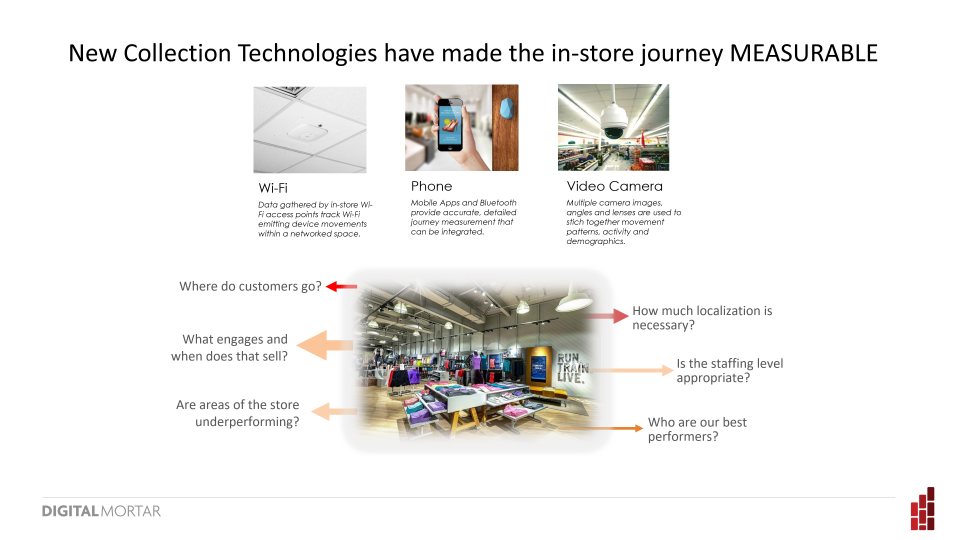An Overview of In-Store Tracking Technology
An Overview of In-Store Tracking Technology
By Gary Angel
|April 12, 2017

How does it work? Can you really do this? Is it legal? Those are the questions that I get asked the most about in-store customer journey tracking. The same kind of questions, to be honest, I used to get fifteen years ago in digital analytics. And when you have to answer questions like these, you know it’s still pretty raw out there. Collection technologies are a core part of measurement – whether it’s tags in digital analytics or PCAP files for in-store customer tracking. Technology matters. And with in-store tracking, the data collection technologies aren’t half-baked, but they aren’t well-cooked either.
Here’s what you need to know:
Collection Technologies
There are four (!) common approaches to in-store customer tracking: camera, wifi, passive network and mobile apps. Each has distinct characteristics and at least some advantages and disadvantages. Camera is pretty easy to understand. The cameras used for in-store measurement are video. Each camera has on-board processors that identify people, “blob” them, and then track them across their field of view. This yields a stream of data that is positionally very accurate and can also identify basic demographics around each visitor. The anonymized data is then passed to a central server where systems like ours can use it.
Your existing WiFi system can also be used to track customer journey data. This works whether or not people login to your access points. Phones regularly ping out looking for a network and those pings – anonymized – can be triangulated to figure out the position. Put those pings together, and you have a journey. One of the best things about WiFi tracking is that almost everybody already has the necessary hardware in place. That means there’s no new installation; and most of the top-tier providers of internet access points make it super easy to route the data directly to your cloud-based system. Often at no additional cost.
Passive network sniffers are small WiFi-like devices designed explicitly for in-store measurement. They work on principles similar to WiFi but they solve some problems that WiFi doesn’t. They track multiple bands, not just passive WiFi pings, and they can deliver better positional accuracy because they can be deployed in very large numbers quite cost-effectively.
Lastly, you can use code inside a mobile application to track the customer journey. Mobile apps can deliver a steady stream of positional data and have the unique benefit of being able to tie that data to the customer’s digital in-app experience.
So what’s not to like?
Well, each technology has some significant issues.
Cameras are expensive, installation is a challenge, each camera only covers a small zone, and camera systems do a remarkably poor job stitching together the customer journey. So as typically delivered, camera systems cost a lot and deliver limited measurement.
WiFi isn’t very accurate positionally – meaning it can’t be used effectively for much beyond door-counting in smaller and mid-size retail spaces. Worse, changes in MAC randomization in the IoS world have essentially eliminated the ability of WiFi systems to passively track customers with Apple devices. That means you either depend on users to connect to your WiFi (which does yield stable measurement) or you only measure your Android customers. Two bad solutions don’t add up to a good one.
Passive network sniffers improve on WiFi in terms of positional accuracy and their ability to fingerprint devices. But they don’t solve those problems perfectly and, of course, they don’t give you the no-installation, no hardware cost convenience that WiFi did.
Measurement using mobile apps? That’s great, just like everything with mobile apps provided you can get customers to actually download the app. Depending on customer app downloads for measurement is inherently a limiting factor.
Bottom line? There are places and times for every technology and there are ways to combine the technologies to yield better results (we do that). But this isn’t measurement nirvana. No solution is perfect and you’ll find plenty of things to hate in any direction you choose.
To get more detail on the ins-and-outs of in-store customer journey tracking technology (and it’s complicated), ping me. I’ll send you a DM whitepaper that gives you everything you need to know to choose wisely!
I’ll tackle practicality and legality next time!